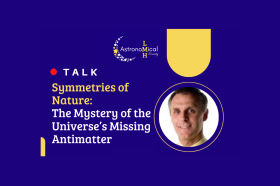
On Friday 12th May, LMH alumnus and Sussex University’s Emeritus Professor of Physics Philip Harris returned to College to give a talk for the LMH Astronomical Society on: “Symmetries of Nature: The Mystery of the Universe’s Missing Antimatter”.
Organised by current LMH undergraduate Elena Selmi (2002, Physics), the talk explored the beauty of symmetry - and the deep and powerful connection between the symmetries of nature and the most fundamental laws of physics. Philip talked those in attendance through some of these symmetries and their consequences for our existence, introducing an experiment that helps to address one of cosmology’s deepest mysteries: why does the Universe contain so much more matter than antimatter?
With his enthusiasm and knowledge, Philip charmed students from the natural sciences as well as those with a humanities’ background. Attendees asked questions about the Big Bang itself, and those who were new to the subject were inspired to look more deeply into the topics Philip discussed. Though the odd technical issue cropped up, Philip kept the audience engaged with the occasional professional anecdote or Winnie the Pooh comic strip, delivering what some people afterwards described as the best talks of the year so far!
Philip was a member of LMH’s first male undergraduate cohort, matriculating in 1979. He spent his career carrying out experiments in atomic and particle physics across Europe and the USA, and is known in particular for his contributions to the measurement of the electric dipole moment of the neutron - one of the most precise measurements that it is possible to make in physics.
The LMH Astronomical Society is a college society which was re-founded in 2022 by a group of LMH Physics undergraduates, aiming to expand the range of events in college by bringing science to the forefront. Striving to be as open to all as possible, the “AstroSoc” has successfully organized a number of events, ranging from talks by renowned scientists to movie nights and stargazing evenings in the LMH gardens. In particular, the society’s crown jewel event, “Cocktails & Constellations”, allowed more than 60 students from all backgrounds to observe for the first time the Moon, Saturn’s rings and Jupiter’s Galilean Moons!